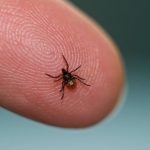Why is Morgellons a controversial condition?
As mentioned earlier, Morgellons disease is considered controversial, because it is a misunderstood condition that has not been researched thoroughly. Additionally, despite evidence of the condition, it has not been classified as a true disease. Rather, it continues to be called a condition of self-diagnosis. Some physicians and psychologists will even call Morgellons disease a psychiatric illness, caused by delusional parasitosis. While research suggests otherwise, it is still oftentimes treated with antipsychotic and antidepressant medication.

Secondly, the subject of the fibers. There are two takes on these formations. Those who believe Morgellons to be psychological will insist that the fibers are coming from clothing or ingrown hair. Those who believe the disease is indeed a bacterial infection will say that the fibers are an immune response.
The history of the condition is partially to blame for the contention. Eruptions of coarse hair from sores on the backs of children has been described in medical records as far back as the 17th century. During that time, those eruptions were called “morgellons.” Then, in 1983, delusional parasitosis received its name when patients complained of insects infesting their skin.
In 2002, the eruptions of “hair” happened again. This time, though, the eruptions were paired with the sensation of bugs beneath the skin. The similarities between two previous conditions gave the medical condition the name Morgellons disease; but because the cause was unknown and partnered with the itchy, crawling sensations, many doctors refused to call it anything other than delusional parasitosis.
By 2006, self-diagnosed cases of Morgellons disease significantly increased, perhaps due to the spread of the World Wide Web. Because of this trend, the CDC launched a study, which was mentioned earlier. Since the study stated that there was no clear cause of the disease, including infestation or infection, researchers and doctors alike continued to believe that Morgellons was all in the heads of their patients.
In 2013, a research group led by Canadian microbiologist Marianne J. Middelveen found a link between Morgellons and a bacteria borne from ticks called Borrelia burgdorferi. Another research group published a study in 2016 that confirmed the association between the tick-borne bacteria and the disease. Later, in 2018, the Charles E. Holman Morgellons Disease Foundation (CEHMDF) argued that the pathology of Morgellons is caused by infection, and they were the ones who found that the fibers were produced by skin cells and colored with melanin.
More from Things Health
-
Heart Disease And Obesity
Binge eating is regarded an eating disorder whenever you cannot stop yourself from eating a lot of food very quickly, even whenever you are not…
-
Liver Disease And Chronic Fatigue
50 percent of the sufferers with an underlying liver condition show no symptoms of the disease. The symptoms are actually very regular, as for instance…
-
Lyme Disease Symptoms
Experts are suggesting that 2017 will be a bad year for ticks. Lyme disorder is propagated by deer ticks and is the result of a…
-
Understanding Crohn's Disease
Crohn's Disease is an Inflammatory Bowel Disease commonly referred to as IBD. Inflammatory Bowel Disease consists of several disorders, the primary two are Crohn's Disease…
-
Cardiovascular Disease And Smoking
Cardiovascular fitness exercise, also called cardiorespiratory fitness exercise and aerobic fitness exercise, continues to be proven to have a number of health advantages when performed…






